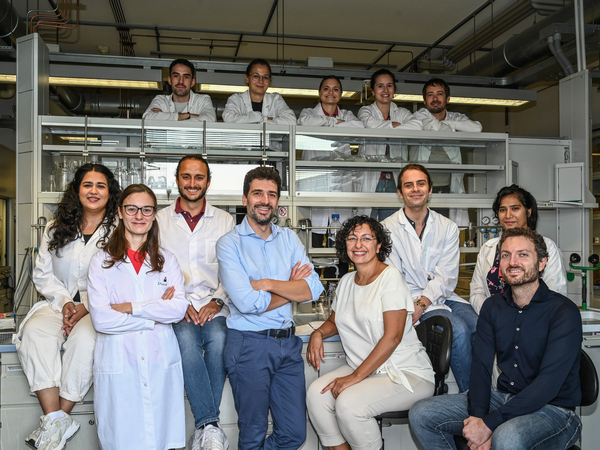A research team from Ca' Foscari, composed of Claudia Crestini, professor of General Inorganic Chemistry, Matteo Gigli, professor of Chemical Fundamentals of Technologies, and PhD student Daniele Massari from the Department of Molecular Sciences and Nanosystems, has patented, in collaboration with Professor Livia Visai and Dr. Nora Bloise from the University of Pavia, the ability to transform chitin into intelligent nanomaterials with functional properties. The process has potential applications in various fields ranging from biomedicine to sustainable packaging, as well as in the restoration and conservation of writing materials.
First of all, what is chitin?
Chitin is one of the most abundant biopolymers in nature. It is a fundamental component of the exoskeletons of insects and crustaceans, and it is in cell walls of fungi and some microalgae. It is, therefore, an important byproduct of the fishing industry and of crab and shrimp processing in particular, from which it can be easily isolated.
The blue crab currently poses a major challenge to the fishing industry in the northeast of Italy, and its proliferation has created a real emergency. The shells of this crab are incredibly rich in chitin, and the research team at Ca' Foscari University is working on isolating it. Aim of the team is to turn the crisis caused by the crab invasion into an unprecedented scientific, technological, and economic opportunity. This venture could open new prospects for an industry and research sector that is constantly evolving.
From a chemical perspective, chitin is a polysaccharide composed of glucose units with amide functionalities, and it is entirely biocompatible.
We have asked Professor Crestini and Professor Gigli to tell us about their research and the recently patented applications.
"Through our process, we can isolate and chemically modify a nanocrystalline fraction of chitin, a completely natural polymer," explains Crestini. "This process can be scaled to industrial level, opening a wide range of possibilities. The resulting nanostructures have been used to develop materials with extraordinarily innovative characteristics, paving the way for new perspectives in materials technology."
Members of the research group are currently focusing on four main applications:
Biomedicine
"Thanks to tailored formulations, we can create two products with very different characteristics," says Gigli.
"The first application has to do with the creation of flexible films. These films, suitably modified with natural substances extracted from lignocellulosic biomass, are used as medical patches. Due to their biocompatibility and hemocompatibility, these films can be used for medical purposes. Their chemical composition can be varied to obtain adhesive or non-adhesive films with heparin-like properties, offering customized solutions for medical needs.
The second application is linked to the creation of 100% natural nail polishes. These polishes, available in various colours, are remarkable for their intrinsic antifungal effect, due to the presence of chitin and chitosan, even in nanostructured form. This makes them ideal for the treatment of onychomycosis, a fungal nail infection. Natural compounds with a bitter aftertaste can also be added to the formula, to fight nail biting. Another advantage is that these polishes are water-based, eliminating the unpleasant smell we associate to traditional nail polishes. This offers a hygienic and natural solution for nail care and cosmetics.
Sustainable Packaging
The third application has to do with packaging, and more specifically with food packaging. Our nanostructured chitin-based films can be used to replace traditional plastics to create completely biobased flexible films. The packaging sector contributes to approximately 40% of global plastic consumption, and the use of renewable resources could have a huge impact. As in the other applications we previously mentioned, the addition of natural compounds to the formula triggers antioxidant and antimicrobial capacities, generating a material that actively protects the contained product."
"This is a very important feature if we want to talk about sustainable economy," adds Claudia Crestini. "The functional properties we just described extend the shelf life of food, by protecting it from processes that accelerate its deterioration. Our films are biodegradable, and this must be emphasised: when recycling is not possible due to contaminants that are not easily separated (for example liquids substances produced by food), our packaging fully meets the principles of circular economy."
Protection and preservation of writing materials
With an eye on sustainability, the research group has been working on a special coating for the restoration and conservation of ancient and modern written materials. The peculiar characteristic of this coating, compared to what is available on the market today, is multivalence, i.e., the ability to slow down and prevent various kinds of decay of inked paper. Chitin contains functional groups that counteract the increase in paper acidity and, as mentioned earlier, have an antimicrobial action than can hinder the proliferation of microorganisms.
In addition, chitin nanostructures prevent the deterioration of the mechanical properties of paper, both from a physical and chemical point of view. The former is achieved by the ability of nanostructures to penetrate inside the sheet and interact with cellulose fibres, strengthening them. The latter is related to the antioxidant capacity of the coating, which slows down the effect of oxygen on paper.
"We have paved the way for an upcycling process, transforming waste biomasses into sustainable and high-value products for a wide range of applications," conclude Crestini and Gigli. "These pioneering results embrace the fields of medicine, cosmetics, packaging, and the preservation of cultural heritage, providing innovative and sustainable solutions. This work not only contributes to the goal of greater environmental sustainability but also offers new perspectives and opportunities in various key sectors."
And this is not all
The versatility of chitin is at the heart of this ongoing effort. Our work focuses on refining this material’s characterizations, to ensure advanced performance and maximum sustainability in existing applications.This innovative thinking spans across new frontiers, such as flexible electronics and sensing, opening up new revolutionary possibilities in fields such as wearable technology and sensory detection.
A drive for progress is characteristic of this research team, which continues to explore and expand prospected developments.











